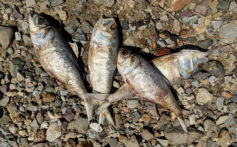Something Stinks!– inspired by a real event
As a children’s writer, my radar is always up for topics of interest to kids. As a lifelong water baby—competitive swimmer, sailor, water skier, and water safety instructor, mostly on lakes and rivers from Michigan to three southern states—I gravitate to all things water. I began to see reports through the southeast of fish kills. Florida’s kills seemed connected to red tide, and they were studied a lot. The fish kills in Virginia were mostly in fresh water, and the articles I read suggested little interest from authorities in investigating the problem.
I wanted to write a middle-grade mystery, and thought the Virginia kids I’d met when we lived there might want to know why the fish were dying, so there was my start.

The manuscript went through many permutations, including one that took it from third person to first. On the surface, this was a minor change, but it really helped give a strong, central voice to the story — that of seventh grader Emily Sanders. Dealing with relatable problems like friends, rules, or homework didn’t stop her from leading some “not hardcore science whizzes+ on an adventure of discovery. Curiosity rules, but the waters were far from smooth.
Tumblehome Books was looking for middle grade mysteries with a science component. I thought, hmm, the kids in my book looked at pollution from several sources, including fertilizer run-off and industrial pollutants. Was that science-y enough? It passed the first reader, and landed with the publisher herself, a medical doctor who also became my editor. Lucky me.
More science!
In a science mystery, there are facts to check, and possible additional information included. I felt not being a scientist gave the book a unique perspective, since I could approach the science discovery process more like the kids would. Like Emily, I was somewhat afraid of not knowing all the answers, but was willing to jump in with both feet.
Fiction meets fact
A basic concept in science is this: something has happened, and some action is needed to find out what and why.
If something’s responsible for a massive fish kill, whether pesticides from a golf course or environmental damage from a faulty logging operation, a trail must be followed — an effect with a cause. Fiction is a vehicle that allows kids to take action to solve the puzzle without relying on adults for everything.
Science is more than people in lab coats peering into test tubes. Through fiction, I found it was possible to show there is an economic side to environmental science. Science involves many skills, from observation and proving a theory, to obtaining financial support, writing up research, and exchanging ideas.
Other elements of fiction
Finally, using fiction allowed me to show that, sometimes, unfounded accusations can cause dire consequences on both sides of a controversy. Proof and the process of proving is important. The Something Stinks! kids had to keep at the process until the mystery of the fish kills was solved or face the consequences.
Today, the types of kills I wrote about are fewer as controls are in place to monitor them. Yet, kills are still happening. The newer causes are algae blooms in fresh water and the continuing puzzle of red tide in salt water. The challenge for young scientists—to locate a cause, such as fertilizer run-off for fresh water, then sound the alarm—is still there. Environmental protection is an ongoing challenge. We must stay vigilant.
So, that’s how this story began, and how it became a book. In another post, I’ll tell you about the origins of Emily’s second adventure.
– Written by Gail Hedrick
Something Stinks! is available here.
Gail Hedrick’s first science novel, Something Stinks!, won a CBC/NSTA Outstanding Science Book award. A second mystery involving Emily, her friends, and a little science is The Scent of Something Sneaky.








